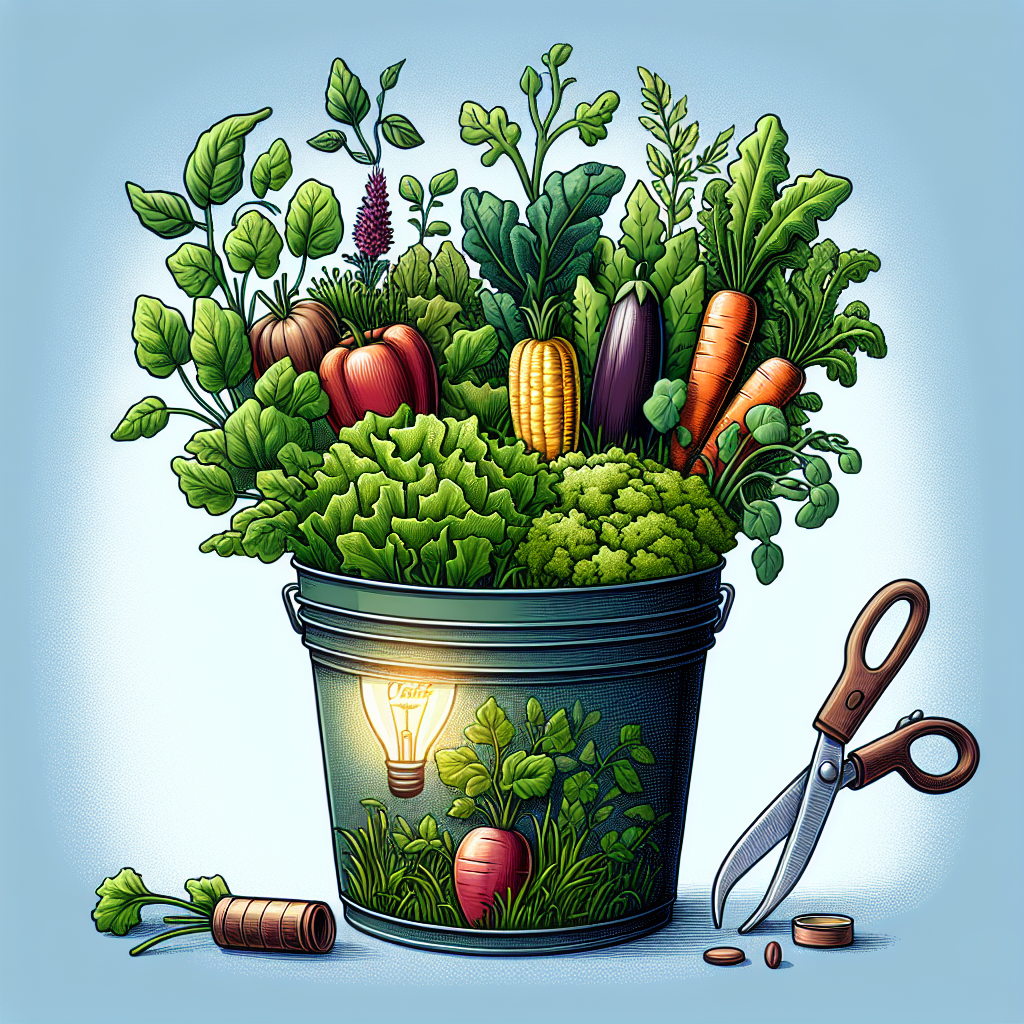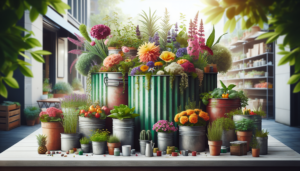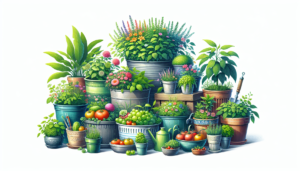
If you’ve always dreamed of having your own vegetable garden but lack the space or resources for a traditional plot of land, container gardening may be the perfect solution for you. With container gardening, you can grow a wide variety of vegetables in pots, buckets, or even recycled containers, right in your own backyard or on your balcony. This article explores the numerous benefits of container gardening for growing vegetables, from its flexibility and convenience to its ability to thrive in small spaces. Get ready to enjoy the satisfaction of harvesting your own fresh, homegrown produce, all while adding beauty and greenery to your outdoor space.
Advantages of Container Gardening
Versatility in Location
Container gardening offers the unique advantage of being able to grow vegetables in various locations. Whether you have a small balcony, a sunny patio, or a limited backyard space, you can create your own vegetable garden by utilizing containers. This versatility allows you to make the most of your available space and adapt to different environmental conditions.
Limited Space
One of the key advantages of container gardening is its suitability for those with limited space. If you live in an apartment or a small house with a small yard, container gardening provides a fantastic solution. By utilizing vertical gardening techniques, hanging baskets, or window boxes, you can maximize your space and still enjoy the satisfaction of growing your own vegetables.
Easy Maintenance
Container gardening is known for its ease of maintenance. Compared to traditional gardening methods, container gardening requires less effort and time. Weeding becomes a minimal task when your vegetables are grown in containers. You can easily move the containers around, making watering, fertilizing, and pruning a breeze. Container gardening simplifies the gardening process, allowing you to enjoy the benefits without the added stress.
Mobility
Another advantage of container gardening is the ability to easily move your plants. This is especially useful if you live in an area with extreme weather conditions. You can protect your vegetables by moving them indoors during cold snaps or storms. Additionally, if you are renting a property and plan to relocate, you can take your container garden with you, ensuring that you can continue to grow your vegetables wherever you go.
Protection from Pests and Diseases
Container gardening provides a certain level of protection against pests and diseases. By keeping your vegetables in containers, you can minimize the risk of insects infesting your plants or diseases spreading from the soil. Container gardening allows you to closely monitor your plants, making it easier to identify and address any issues before they become major problems.
Choosing Containers for Vegetable Gardening
Size and Depth
When choosing containers for vegetable gardening, it is important to consider the size and depth of the containers. The size should be appropriate for the type of vegetable you wish to grow, ensuring that it has enough space to develop healthy roots. The depth of the container should be sufficient to accommodate the root depth of the vegetable to ensure proper growth and development.
Material
Containers come in various materials, including clay, plastic, and wood. Each material has its own advantages and considerations. Clay containers are durable and provide good insulation for the roots, but they may be heavier and prone to cracking. Plastic containers are lightweight, affordable, and retain moisture well, but they may not be as aesthetically pleasing. Wood containers are natural and provide good insulation, but they may deteriorate over time if not properly maintained. Consider the pros and cons of each material and choose one that suits your needs and preferences.
Drainage
Proper drainage is essential for successful container gardening. Ensure that the containers you choose have adequate drainage holes to prevent waterlogged soil, which can lead to root rot. If the container lacks drainage holes, you can drill them yourself to avoid water stagnation. Additionally, using a drainage layer such as rocks or broken pottery at the bottom of the container can further facilitate water drainage.
Temperature Control
Different vegetables have varying temperature preferences. Some thrive in warmer conditions, while others prefer cooler temperatures. Choosing containers that are appropriate for your climate and the types of vegetables you wish to grow allows for better temperature control. Consider using insulated containers or placing containers in areas that provide shade or sun exposure as needed.
Selecting the Right Vegetables
Consider Space and Size
When selecting vegetables for container gardening, consider the space and size constraints of your chosen containers. Choose vegetables that are suitable for small spaces and have compact growth habits. For example, cherry tomatoes, herbs, lettuce, and radishes are excellent choices for container gardening due to their smaller size and ability to grow well in confined spaces.
Sunlight Requirements
Different vegetables have varying sunlight requirements. Some thrive in full sun, while others prefer partial shade. Before selecting vegetables for your container garden, assess the sunlight conditions of the chosen location. Choose vegetables that are compatible with the amount of sunlight available to ensure optimal growth and productivity.
Root Depth
Vegetables with deeper root systems require containers with adequate depth. Consider the specific root depth requirements of the vegetables you wish to grow and choose containers that can accommodate their growth. This allows the plants to develop healthy root systems, leading to better nutrient uptake and overall plant health.
pH Requirements
pH is an essential factor to consider when selecting vegetables for container gardening. Some vegetables prefer acidic soil, while others thrive in more alkaline conditions. Understanding the pH preferences of your chosen vegetables will help you select the appropriate soil mix or make necessary adjustments to provide the ideal pH for optimal growth.
Companionship
Planting vegetables with compatible companions can enhance growth and improve yield. Certain vegetables have mutually beneficial relationships, such as repelling pests or providing shade for each other. Consider companion planting strategies when selecting vegetables for your container garden to maximize the benefits of intercropping.
Preparation and Planting
Choosing Soil Mix
The quality of soil is crucial for the success of container gardening. Opt for a high-quality soil mix that is well-draining and nutrient-rich. Avoid using garden soil alone, as it tends to be heavy and can cause drainage issues. A recommended soil mix for container gardening consists of equal parts potting soil, compost, and perlite or vermiculite to create a balanced and nutrient-dense medium.
Planting Techniques
When planting vegetables in containers, ensure they are spaced appropriately to allow for proper growth and airflow. Follow the recommended planting depth for each vegetable, as this is essential for establishing healthy root systems. Gently loosen the root ball before placing the plant in the container and carefully backfill with soil, ensuring the plant is firmly supported. Water thoroughly after planting to settle the soil and provide initial hydration to the plant.
Watering and Fertilizing
Proper Watering Techniques
Proper watering is crucial for container-grown vegetables. Containers tend to dry out more quickly than traditional garden beds, so it is important to monitor the moisture levels regularly. Check the top inch of soil with your finger, and if it feels dry, it’s time to water. Apply water evenly over the soil surface, ensuring it reaches the roots. Avoid overwatering, as this can lead to root rot, and underwatering, which can result in stressed plants.
Fertilizing Container Vegetables
Container-grown vegetables may require more frequent fertilization compared to those grown in the ground. Use a balanced, slow-release fertilizer or organic compost to provide essential nutrients throughout the growing season. Follow the manufacturer’s instructions for the appropriate amount and frequency of application. Regularly monitor the plants for signs of nutrient deficiency or excess, and adjust fertilization accordingly.
Pruning and Training
Pruning for Better Growth
Pruning is an important practice in container gardening to promote better growth and productivity. Regularly remove any dead or diseased leaves to prevent the spread of diseases and pests. Pinch off the tips of vining plants to encourage branching and fuller growth. Prune out any overcrowded or weak stems to increase air circulation and reduce the risk of fungal infections. Proper pruning techniques maintain the health and vigor of the plants, leading to better fruit production.
Training Techniques in Containers
Training techniques, such as staking or trellising, can be beneficial for certain vegetables in containers. Vining vegetables, like tomatoes or cucumbers, can be trained to grow vertically on stakes or trellises, maximizing space and preventing sprawling growth. Secure the plants gently to the support structure, ensuring they have room to grow and are not overly constrained. Training helps maintain the plants’ health and improves the aesthetics of your container garden.
Pest and Disease Control
Identifying Common Pests and Diseases
Container gardening does not completely eliminate the risk of pests and diseases, but it does provide some protection. Regularly inspect your plants for signs of common pests, such as aphids, caterpillars, or fungal infections. Actively monitor for any changes in plant health or the presence of pests to address issues promptly and prevent further damage.
Preventive Measures
To minimize the risk of pests and diseases in container gardening, practice preventive measures. Choose disease-resistant varieties when possible, and maintain good sanitation practices by regularly cleaning containers and equipment. Avoid overcrowding plants, as this can create a favorable environment for disease development. Additionally, practicing crop rotation by changing the location of containers each growing season can help prevent the buildup of pests and diseases in the soil.
Organic Pest and Disease Control
If pests or diseases do occur, organic pest and disease control methods can be employed. Utilize natural predators, such as ladybugs or beneficial insects, to combat common pests. Homemade or commercial organic sprays, like neem oil or insecticidal soap, can be used to control pests while minimizing harm to beneficial insects. For diseases, organic fungicides or biological control methods can help mitigate the spread and impact of fungal infections.
Harvesting and Preserving
Timing the Harvest
Knowing when to harvest your vegetables is crucial for obtaining optimal flavor and texture. Each vegetable has its own indicators of maturity, such as color change, firmness, or size. Pay attention to these signs and harvest when the vegetables are at their peak ripeness. Harvesting too early or too late can result in subpar taste and texture.
Proper Harvesting Techniques
Use appropriate tools, such as sharp pruners or shears, to ensure clean cuts when harvesting vegetables. Avoid damaging the plants by gently handling them and supporting them while harvesting. If necessary, refer to specific guidelines for each vegetable to ensure you are harvesting correctly, as some vegetables may require a specific technique or timeframe for harvesting.
Techniques for Preserving Vegetables
Container gardening allows you to enjoy a bountiful harvest, but it may yield more vegetables than you can consume immediately. To preserve your vegetables, consider methods such as canning, freezing, or drying. Each preservation technique has its own requirements, but they all allow you to enjoy your homegrown vegetables throughout the year and reduce food waste.
Creative Container Ideas
Vertical Gardening
Vertical gardening is an excellent way to maximize space when container gardening. By utilizing trellises, stakes, or vertical planters, you can make use of the vertical space available, allowing your plants to grow upward instead of sprawling outward. This technique is especially useful for vine vegetables like beans, cucumbers, or peas.
Hanging Baskets
Hanging baskets are not only aesthetically pleasing but also functional for container gardening. They provide a creative way to elevate your vegetable garden, saving valuable floor space. Hanging baskets are ideal for growing trailing vegetables like cherry tomatoes, strawberries, or trailing herbs, adding a beautiful cascading element to your garden.
Window Boxes
Window boxes offer a charming and practical solution for container gardening. Placed on windowsills or railings, they allow you to grow a variety of vegetables right outside your window. Window boxes are especially useful for growing shallow-rooted vegetables like lettuce, herbs, or small peppers. They bring beauty and convenience to urban spaces or apartments with limited outdoor areas.
Herb Towers
Herb towers are a creative and space-saving option for container gardening. Vertical herb towers are self-contained structures that allow you to grow multiple herbs in a small footprint. By stacking pots on top of each other, the tower provides a visually striking display while keeping your favorite herbs at your fingertips for culinary use. This idea is perfect for growing a variety of herbs such as basil, parsley, or rosemary.
Environmental and Health Benefits
Reduced Carbon Footprint
Container gardening contributes to reducing your carbon footprint. By growing your own vegetables, you decrease the demand for commercially grown produce that often requires transportation over long distances. Additionally, container gardening allows you to utilize organic and sustainable gardening practices, minimizing the need for chemical inputs and harmful pesticides.
Access to Fresh Produce
Having your own container garden grants you immediate access to fresh and nutritious produce. Harvesting your vegetables at peak ripeness ensures optimal flavor, quality, and nutritional value. Container gardening empowers you to create a sustainable food source that offers an abundance of fresh vegetables right at your doorstep.
Relaxation and Stress Relief
Container gardening provides a peaceful and therapeutic escape from daily stressors. Engaging in gardening activities, such as planting, watering, or tending to your plants, promotes relaxation and mindfulness. The soothing nature of container gardening not only benefits your mental well-being but also provides an opportunity to connect with nature and appreciate the beauty of the growing process.
Educational Opportunities
Container gardening offers endless educational opportunities, especially for children. Involving kids in container gardening allows them to learn about plant life cycles, the importance of nutrition, and the beauty of nature. It helps cultivate an appreciation for the environment, encourages curiosity, and fosters a sense of responsibility and self-sustainability.
In conclusion, container gardening presents numerous advantages for growing vegetables. Whether you have limited space, want to explore creative gardening ideas, or simply seek a low-maintenance and versatile gardening method, container gardening has got you covered. By carefully selecting containers, choosing the right vegetables, and practicing proper planting techniques, watering, and care, you can enjoy the rewards of a flourishing garden and the satisfaction of growing your own fresh, healthy produce. So grab your containers, get your hands dirty, and embark on a rewarding container gardening journey. Happy gardening!







